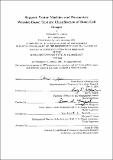| dc.contributor.advisor | Roy E. Welsch, Rami S. Mangoubi and Mukund N. Desai. | en_US |
| dc.contributor.author | Jeffreys, Christopher G. (Christopher Grey), 1979- | en_US |
| dc.contributor.other | Massachusetts Institute of Technology. Operations Research Center. | en_US |
| dc.date.accessioned | 2005-05-17T14:48:08Z | |
| dc.date.available | 2005-05-17T14:48:08Z | |
| dc.date.copyright | 2004 | en_US |
| dc.date.issued | 2004 | en_US |
| dc.identifier.uri | http://hdl.handle.net/1721.1/16651 | |
| dc.description | Thesis (S.M.)--Massachusetts Institute of Technology, Sloan School of Management, Operations Research Center, 2004. | en_US |
| dc.description | Includes bibliographical references (p. 117-121). | en_US |
| dc.description | This electronic version was submitted by the student author. The certified thesis is available in the Institute Archives and Special Collections. | en_US |
| dc.description.abstract | Stem (cell research is one of the most promising and cutting-edge fields i the miedical sciences. It is believed that this innovative research will lead to life-saving treatments in the coming years. As part of their work, stem cell researchers must first determine which of their stem cell colonies are of sufficiently high quality to be suitable for experimental studies and therapeutic treatments. Since colony texture is a major discriminating feature in determining quality. we introduce a non-invasive, semi-automated texture-based stem cell colony classification methodology to aid researchers in colony quality control. We first consider the general problem of textural image segmentation. In a new approach to this problem. we characterize image texture by the subband energies of the image's wavelet decomposition, and we employ a non-parametric support vector machine to perform the classification that yields the segmentation. We also adapt a parametric wavelet-based classifier that utilizes the Kullback-Leibler distance. We apply both methods to a set of benchmark textural images, report low segmentation error rates and comment on the applicability of and tradeoffs between the non-parametric and parametric segmentation methods. | en_US |
| dc.description.abstract | (cont.) We then apply the two classifiers to the segmentation of stem cell colony images into regions of varying quality. This provides stem cell researchers with a rich set of descriptive graphical representations of their colonies to aid in quality control. From these graphical representatiolns, we extract colony-wise textural features to which we add colony-wise border features. Taken together, these features characterize overall colony quality. Using these features as inputs to a multiclass support vector machine, we successfully categorize full stem cell colonies into several quality categories. This methodology provides stem cell researchers with a novel, non-invasive quantitative quality control tool. | en_US |
| dc.description.statementofresponsibility | by Christopher G. Jeffreys. | en_US |
| dc.format.extent | 121 p. | en_US |
| dc.format.extent | 2545793 bytes | |
| dc.format.extent | 3318038 bytes | |
| dc.format.mimetype | application/pdf | |
| dc.format.mimetype | application/pdf | |
| dc.language.iso | eng | en_US |
| dc.publisher | Massachusetts Institute of Technology | en_US |
| dc.rights | M.I.T. theses are protected by copyright. They may be viewed from this source for any purpose, but reproduction or distribution in any format is prohibited without written permission. See provided URL for inquiries about permission. | en_US |
| dc.rights.uri | http://dspace.mit.edu/handle/1721.1/7582 | |
| dc.subject | Operations Research Center. | en_US |
| dc.title | Support vector machine and parametric wavelet-based texture classification of stem cell images | en_US |
| dc.type | Thesis | en_US |
| dc.description.degree | S.M. | en_US |
| dc.contributor.department | Massachusetts Institute of Technology. Operations Research Center | |
| dc.contributor.department | Sloan School of Management | |
| dc.identifier.oclc | 56472941 | en_US |
